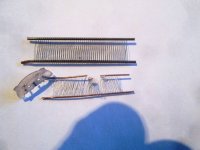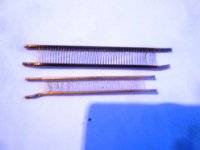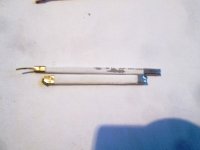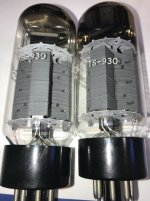Approximations and Generalizations:
The 7591 has about 1.6X to 2X the transconductance more than a 6L6.
The 7591 has about 2X more g1 to g2 mu (u), than a 6L6.
The 7591 bias voltage in a typical circuit is only about 1/2 of the bias voltage of a 6L6.
Consider that the 7591 is easyier to drive;
The 6L6 requires more drive voltage.
Also, if I was a vacuum tube manufacturer, I might want to take away some business from another vacuum tube manufacturer.
Just my 2 Cents.
I designed and built both 6L6GC, and 7591S amplifiers.
I like them both, but I tend to use them with different operating conditions.
The 7591 has about 1.6X to 2X the transconductance more than a 6L6.
The 7591 has about 2X more g1 to g2 mu (u), than a 6L6.
The 7591 bias voltage in a typical circuit is only about 1/2 of the bias voltage of a 6L6.
Consider that the 7591 is easyier to drive;
The 6L6 requires more drive voltage.
Also, if I was a vacuum tube manufacturer, I might want to take away some business from another vacuum tube manufacturer.
Just my 2 Cents.
I designed and built both 6L6GC, and 7591S amplifiers.
I like them both, but I tend to use them with different operating conditions.
Last edited:
The original 7591 was a great output tube. The modern day iterations not so much as they were/are sensitive to grid resistance and could go "over the hill" so to speak. At least that's what I read online. Whether they were made as a compact 6L6 I'm not sure. But some more compact versions do exist in the 6L6WGB and the original Tung Sol 5881. I'm a fan of all three.
Was this tube primarily intended to replace the 6L6 for use in more compact cabinets? I see that fans of each tube exist. Do I remember seeing a compact 6L6 also?.
The 6L6 design is ancient and has a lot of IMD as well as copious THD, just like the 807, which is basically the same valve.
The compact 6L6 could be considered to be STC 5B25xM, a loctal base valve which is a highly miniaturised 807, and exists without top cap.
The 7591 is a much higher quality more modern valve designed by Westinghouse, having much lower distortion.
I am a great admirer of Westinghouse who designed this excellent valve for Fisher, Scott and Bogen, then passed it on to Sylvania to make properly in quantity.
Think of it as a cross between a highly boosted 6V6 (Westinghouse made 6V6 that have the same 7591 anode struct), and a half 8417.
In fact if you run a matched quad of 7591 (which of course Bogen did with the 7868) you get the same power as a pair of 8417... ie. around 100W with no effort at all.
The magnoval 7868 is a miniaturised version of the 7591, and the 6GM5 is a noval miniaturised version of the 7868.
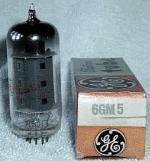
Then little known Brimar came along and made the EL506 which is esentially the same as the 7868....All of them a quantum leap better than the 6L6, but of course Guitar players aren't interested in clean undistorted sounds....

Luckily another little known valve also shares very similar characteristic with the 7591.
Not saying what of course.
Converted my 6BQ5 PP amp to 6GM5 after researching Eico ST40, ST70, and Pio SA-810 designs. About same time, thread link below gave good comparo I thought interesting-
New 7591A Amp Design, 35W x2
Jim
New 7591A Amp Design, 35W x2
Jim
I think while not being entirely scientific the link that attempted to compare distortion signatures is somewhat telling.
The 7591 appears to have by far the lowest distortion in the critical 20mW-12W output zone.
That speaks volumes, and most people seem to have a similar opinion, that it sounds "clean", with quite incredible power from such a small component.
A lot can be explained by the alignment and current of the screen grid for high loads.
The 6L6GC/807 has a very coarse screen wire pitch (by modern standards), but extremely well aligned leading to high efficiency, low screen current but high IMD.
Here's a comparison of a modern pentode wire pitch with the old 6L6oids.
What is obvious are the comparatively huge (high perveance) cathodes on modern valves, the much finer tolerances everywhere, and clearly non aligned electrodes typical of pentodes leading to high (or excessive) screen currents.
(photo)
Westinghouse went this route with the very compact 7591, which has a similar (high) transconductance to the EL34, while they then did the downright astonishing 8417, then philips with the even madder EL503/520.
Luckily a few of the later TV types went down a similar route...
The 7591 appears to have by far the lowest distortion in the critical 20mW-12W output zone.
That speaks volumes, and most people seem to have a similar opinion, that it sounds "clean", with quite incredible power from such a small component.
A lot can be explained by the alignment and current of the screen grid for high loads.
The 6L6GC/807 has a very coarse screen wire pitch (by modern standards), but extremely well aligned leading to high efficiency, low screen current but high IMD.
Here's a comparison of a modern pentode wire pitch with the old 6L6oids.
What is obvious are the comparatively huge (high perveance) cathodes on modern valves, the much finer tolerances everywhere, and clearly non aligned electrodes typical of pentodes leading to high (or excessive) screen currents.
(photo)
Westinghouse went this route with the very compact 7591, which has a similar (high) transconductance to the EL34, while they then did the downright astonishing 8417, then philips with the even madder EL503/520.
Luckily a few of the later TV types went down a similar route...
Attachments
Eric Barbour wrote a great article on the development of the 7591 in volume 20 of Vacuum Tube Valley 2003 7591 - The Space Saver. He reports that it was developed as a consumer electronics output device priced at about 25% of a 6L6GLC. Used in heaps of audio, often operated right at its limits. A good read and great research.
Eric Barbour wrote a great article on the development of the 7591 in volume 20 of Vacuum Tube Valley 2003 7591 - The Space Saver. He reports that it was developed as a consumer electronics output device priced at about 25% of a 6L6GLC. Used in heaps of audio, often operated right at its limits. A good read and great research.
link to vol.20:
https://web.archive.org/web/2013060.../Pioneering-Wireless/eMagazines/VTV/VTV20.pdf
all 20 issues:
Pioneering Wireless (Radio) - eMagazines
Thank you, everyone, for the helpful replies. Although I was aware of the technically better specs for the 7591, compared with the 6L6, because the old tube is still highly regarded, that had me wondering if specs necessarily translated into better sound. I'm guessing that: perhaps yes, but only with certain circuits and OPTs.
In my rather limited experience, the 7591 is more dynamic with better "slam". Still, the 6L6 creates some nice sounds in guitar amps. BTW, I find the 6V6 also plays beautiful music within it's power range.
In my rather limited experience, the 7591 is more dynamic with better "slam". Still, the 6L6 creates some nice sounds in guitar amps. BTW, I find the 6V6 also plays beautiful music within it's power range.
Interesting history...
How does the 7581 and 7581a come into this history?
Those seem like slightly larger versions of a 6L6GC.
The "low loss base" terms were generally associated with RF tubes, but did often work better in an audio amp for a different reason.
The old black Bakelite base and the brown "glue" that held the glass in the base could absorb moisture in a high humidity environment like south Florida. Add some dust, and maybe some sweat and beer (OK, a guitar amp played outside or in a pub) and you can get leakage through the base from pin to pin. I have seen measurable resistance in a cold unplugged tube. I have also seen carbon tracking from pin 3 to pin 2 in the base.
The brown or red (pricey RCA's) low loss bases didn't seem prone to this, but then again, I never saw many of these (in any) on 6L6GC's. Tungsol did use them on their 5881's and 6AR6's. They turned an ugly shade of brown when beat hard, but didn't break down or arc over.
The 6AR6 has the pins rearranged to put nothing next to the plate pin. This allows a DC plate voltage of up to 565 volts. The 6AR6 and the Bendix "blow proof" version, the 6384 were once a popular conversion in guitar amps, making these tubes somewhat uncommon today.
The old black Bakelite base and the brown "glue" that held the glass in the base could absorb moisture in a high humidity environment like south Florida. Add some dust, and maybe some sweat and beer (OK, a guitar amp played outside or in a pub) and you can get leakage through the base from pin to pin. I have seen measurable resistance in a cold unplugged tube. I have also seen carbon tracking from pin 3 to pin 2 in the base.
The brown or red (pricey RCA's) low loss bases didn't seem prone to this, but then again, I never saw many of these (in any) on 6L6GC's. Tungsol did use them on their 5881's and 6AR6's. They turned an ugly shade of brown when beat hard, but didn't break down or arc over.
The 6AR6 has the pins rearranged to put nothing next to the plate pin. This allows a DC plate voltage of up to 565 volts. The 6AR6 and the Bendix "blow proof" version, the 6384 were once a popular conversion in guitar amps, making these tubes somewhat uncommon today.
Micanol is the name of the low-loss yellow-brown tube bases. Y was added to the suffix of most tubes that used it. So a 6L6GC with micanol base would be a 6L6GCY. (I don't know if they were ever made.) Ceramic was also used in low-loss tube bases, normal suffix X. Both absorb less moisture than Bakelite, so were prefered in high humidity areas like the south pacific in WWII.
Hmmm, the "blow proof" 6BQ base used by 6AR6 and 6384 might be what was on that TS-930 tube in another thread. ( odd Kepco HB___ power supply tube)
That tube looked like it had grid 3 on pin 1 (and so maybe the cathode there too), the plate on pin 3, and looked like grid 2 on pin 2, but maybe that was just a support wire. No one ever decoded the other base pin connections, so I couldn't trace the tube type in the known tube base's.
That tube looked like it had grid 3 on pin 1 (and so maybe the cathode there too), the plate on pin 3, and looked like grid 2 on pin 2, but maybe that was just a support wire. No one ever decoded the other base pin connections, so I couldn't trace the tube type in the known tube base's.
Attachments
Last edited:
At one time I had three different versions of the Kepco BHK series power supplies. They use another unique tube, the GE 8068. It is basically a 6CD6 with a wimpy cathode and heater (6.3V @0.9 A VS 6.3V @ 2.5 A).
Some users simply stuffed 6CD6's in their supplies (there are 8 of them) causing a power transformer meltdown. I have a good supply of the tubes, but sold all the power supplies except for the one I blew up by using it to blow stuff up.
The 8068's do poorly as push pull amp tubes due to their wimpy heater / cathode system. They might do fine in an UNSET amp, and will be tested there soon.
Some users simply stuffed 6CD6's in their supplies (there are 8 of them) causing a power transformer meltdown. I have a good supply of the tubes, but sold all the power supplies except for the one I blew up by using it to blow stuff up.
The 8068's do poorly as push pull amp tubes due to their wimpy heater / cathode system. They might do fine in an UNSET amp, and will be tested there soon.
Those seem like slightly larger versions of a 6L6GC.
Yes 35W plate dissipation like the other model mentioned
My guess is that they eleminated the "stem" used at previous octals whereQu’est-ce que c’est “low loss base”?????? I’ve seen that before, but what exactly were they worried about “losing”? Can the plastic base actually eat enough high frequency to matter?
all connections were cramped in a glass stem . 7591 was made with all connections coming out in the octal sockets position thius needed only
a thin holder for the pins.
Cramping all connections in the stem will increase capacitance.
Today JJ makes all octals with the same technology, i.e. all connections comes
out of the bottom and goes straight to the pins in teh socket.
Last edited:
The magnoval 7868 is a miniaturised version of the 7591, and the 6GM5 is a noval miniaturised version of the 7868.
I cringe whenever I see the 7868 mentioned. The newer version are expensive and last only a few hours in my Fisher receiver (which mostly sits on a shelf unused.)
- Home
- Amplifiers
- Tubes / Valves
- Reason for 7591 Development
